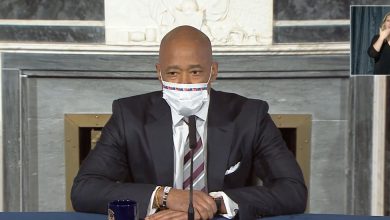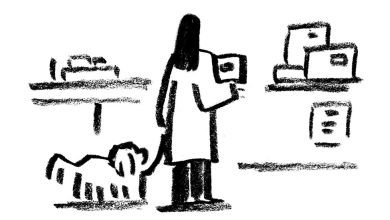Migrant Crisis Tests New Yorkers Who Thought They Supported Immigration

Carin Bail said she was walking with a friend in Queens this spring when they stopped to talk with a woman who was holding a baby and crying. The woman had just arrived at a nearby migrant shelter, she explained in Spanish, and her baby would not eat the food there.
Ms. Bail bought the woman baby food and diapers. “What tugged at my heartstrings,” she said, “was she had a kid with her.”
Yet Ms. Bail, who teaches special education and yoga in public school, opposes the migrant shelters, and has spoken at rallies against them. She complained of overcrowding at her school, in Jamaica, Queens, which recently took in 132 students, many of whom do not speak English.
When asked to describe her feelings toward the migrants, she paused. Her own parents immigrated to the United States after the Holocaust, seeking a better life.
“These are human beings who deserve a chance at life and opportunities,” she said. “My heart goes out to some of these folks. But then on the flip side, I feel that our government and our leadership have been failing us. There’s not one positive outcome that has come from this yet. And it seems like it’s just heading toward a downward spiral.”
New York has long proclaimed its openness to new arrivals, enshrined in the welcoming words on the Statue of Liberty. But the influx of more than 110,000 migrants in a little more than a year, and the strain on the city’s already stretched resources, has called that openness into question. What happens when the tired, huddled masses are suddenly not a poetic conceit but a continuous tide of very needy newcomers, living in temporary shelters or school buildings in residential neighborhoods?
“People are extremely internally conflicted,” said Don Levy, director of the Siena College Research Institute, which has polled New Yorkers on their attitudes toward the migrants.
The migrants — a mix of Venezuelans, West Africans, Afghans and others — began to arrive in significant numbers last spring, driven from their home countries by poverty or political strife, and drawn to New York for its job opportunities and generous public services. In a city whose population is more than one-third foreign-born, the influx, swelling to fill more than 200 shelters, has divided neighbors and families.
In polls, large majorities of New Yorkers say immigrants bring new vitality to the country, and that the current migrants want only to build a better life. They reject the suggestion that immigrants want handouts or that they bring crime or drugs.
But majorities also say the recent influx of migrants is a “serious problem,” and that it is time to slow or stop the flow of new arrivals. Nearly half say migrants to the state over the past 20 years have been a “burden” rather than a “benefit.”
Mr. Levy said New Yorkers fall into three comparably sized categories. About a third hold generally negative views of the migrants. Another third are resolutely supportive. That leaves a large swath in the middle, Mr. Levy said.
“They agree that migration and immigrants have built this country,” he said. “But then they turn around and go, ‘What about now?’” He mentioned makeshift tent shelters and an intake center at a Midtown Manhattan hotel that was so overcrowded that migrants slept outside on the sidewalk, an emblem of a failing system. When otherwise-supportive New Yorkers see such scenes, Mr. Levy said, their reaction is often, “‘This can’t be.’ So there’s an internal conflict and there’s a frustration.”
For many New Yorkers, the migrant crisis was once an abstraction — something they see on the news or hear about in budget statistics. For Aruna Raghavan, who lives near the Brooklyn Navy Yard, the abstraction became real in late summer, when the city opened a shelter for as many as 2,000 single men a few blocks from her home.
“It just happened overnight,” she said. “Nobody was consulted. There was no heads up to the community.”
She noticed more litter on the street and men hanging out under the elevated highway; stores in the neighborhood complained that foot traffic would drop because people were afraid to go near the shelter.
But she said the problems that many neighbors predicted have not materialized. The men she passes on the street have been “very respectful,” and the ones she speaks to say they just want to work but are prevented by regulations. If they were loitering outside buildings, she said, it was in search of free Wi-Fi to better their circumstances.
“I understand people being concerned, but it’s important to have a personal engagement with the people, rather than just chatter about it because it seems to be the topic of the day,” she said.
But she added that the city and its business sector were failing both the migrants and the people living around them.
“I don’t understand why we’re not getting more corporate involvement from big companies that can afford it,” she said. “It would take nothing for large corporations to set up basic infrastructure within these shelters, to help with their application process and their job search. It takes nothing to sponsor a room of 10 computers connected to the internet where they can actually do some work to get out of the situation they’re in.”
Mayor Eric Adams has said that the migrants will cost the city $5 billion this fiscal year, and warned that the influx “will destroy New York City.” But by many measures, the city was fraying well before the migrants started to arrive last year. The coronavirus pandemic emptied much of Manhattan, gutting retail businesses and city tax revenues and leading economists to warn of an “urban doom loop.” Repeated sightings of rats on the streets and emotionally disturbed people on the subways contributed to a sense of a city unraveling.
The surge of migrants, federally barred from working for six months, exacerbated frustrations that were already building.
In College Point, Queens, a working-class neighborhood near La Guardia Airport, Jennifer Shannon, 53, said she believed in helping those in need, including the women in a homeless shelter that opened there in 2019. But after a respite center for migrants opened in July, Ms. Shannon was livid.
“We just added 500 more people to a community that’s already falling apart,” she said.
During the early days of the pandemic, Ms. Shannon started a neighborhood association to support food pantries and provide meals to emergency medical workers, earning citations from Mr. Adams — who was then Brooklyn borough president — and State Senator John Liu.
But now she says the migrants have devalued life in the neighborhood.
“We have people sitting all over people’s private property, drinking, smoking marijuana, hanging out until 4 in the morning in the municipal lot, blasting music,” she said. “It’s a disgrace.”
“It’s not everybody in there. You have people who are genuinely just trying to get away from hell and make a better life for themselves. But that’s not who you see sitting in the park benches at 11 o’clock at night, with their friends, men urinating in broad daylight. That’s what we’re seeing.”
She said her opposition to the shelter was not racial, pointing out that her husband is Mexican. “I’m not against helping people. But what’s going on in our community is unacceptable.”
Mr. Liu, whose senate district includes a large immigrant population, said many of the complaints about migrants were not coming from areas that have been traditionally anti-immigrant. Instead, he said, protests followed the shelters, so “even in parts of the city that tend to be very pro immigrant, many of those residents are up in arms.”
Jaslin Kaur, 27, saw frustrations rise in her largely-immigrant neighborhood in eastern Queens after the city opened a 1,000-bed tent shelter at Creedmoor Psychiatric Center in Queens Village, where hundreds of people have converged to protest since August. When Ms. Kaur organized a small counter-demonstration supporting the migrants, she said, opponents screamed at her and posted her identity and home address on social media.
“To see this kind of backlash against people who look like me and have really horrible stories about what it took for them to get to this city — it’s not the neighborhood I know,” she said, “not the neighborhood I grew up in.”
She said migrants were being blamed for fiscal problems created by years of government neglect. She recalled the period after Sept. 11, 2001, when her father, a Sikh, stopped wearing his turban in his taxi to avoid being attacked. “So it’s really hard to see immigrant communities facing this kind of hatred all over again, but for a different reason,” she said.
A flashpoint of conflict is the school system, where plans last spring to press gyms and auditoriums into service as emergency shelters sparked an angry backlash. In Astoria, Queens, Shabbir Suhal, 40, an accountant with three children in public school, said he was alarmed by published reports of students from shelters being permitted to attend school without being immunized against polio, measles, chickenpox and other diseases. Under state law, students in temporary housing have 30 days to start the process of getting immunized.
“I don’t think it’s safe for my kids,” Mr. Suhal said. “I don’t think this is right.”
Mr. Suhal, whose family immigrated to the United States from Bangladesh when he was 12, said New York could no longer afford to be a sanctuary city. It particularly galled him to see migrants housed in a local building called the Collective Paper Factory, a “hipster hotel” that he and his family cannot afford.
But he said he hesitated to voice his views in public.
Supporters of the migrants “have become successful at making people afraid to speak their minds,” he said. “It’s everywhere. I’m sure a lot of politicians want to say the right thing, but they can’t, because the No. 1 message is that he’s a racist, he’s anti-immigrant. We shouldn’t be afraid to speak our minds.”
A lifelong Democrat, Mr. Suhal said he was now becoming more of a Republican, and a conservative one.
On a balmy afternoon in late September, Debra Michlewitz, 71, a retired public school teacher, worried about pending cuts to the school system, which is already strained by the surge of migrants and the effects of the pandemic shutdown.
“It would be unrealistic to say that New York can absorb every single person that needs to come right now,” she said.
But when she looked at the indigent migrants, she thought of her own parents. They came to New York after World War II, after President Harry Truman issued an executive order that opened the door to Jewish refugees, against opposition from Congress. Like the current arrivals, Ms. Michlewitz’s parents slept and ate their first meals in facilities for new migrants.
Though she worried about the financial strain posed by the recent arrivals, she said, New York was resilient. It survived the crises of the 1970s; it would survive the current challenges.
“I think we have no choice,” she said. “It’s the right thing to do. I would feel terrible telling anyone I don’t think we should make room for them. That’s selfish. People didn’t want to make room for my family, and it was only when a president made it happen that they came here.
“It’s personal for me. And there are other people who have stories like this, and if they’re not remembering that their families were immigrants, it’s not right. They need to have empathy.”
In the meantime, as the city continues to add more and larger migrant shelters, tensions will likely spread to more communities.
Ten thousand more migrants are expected to arrive in the next month.





